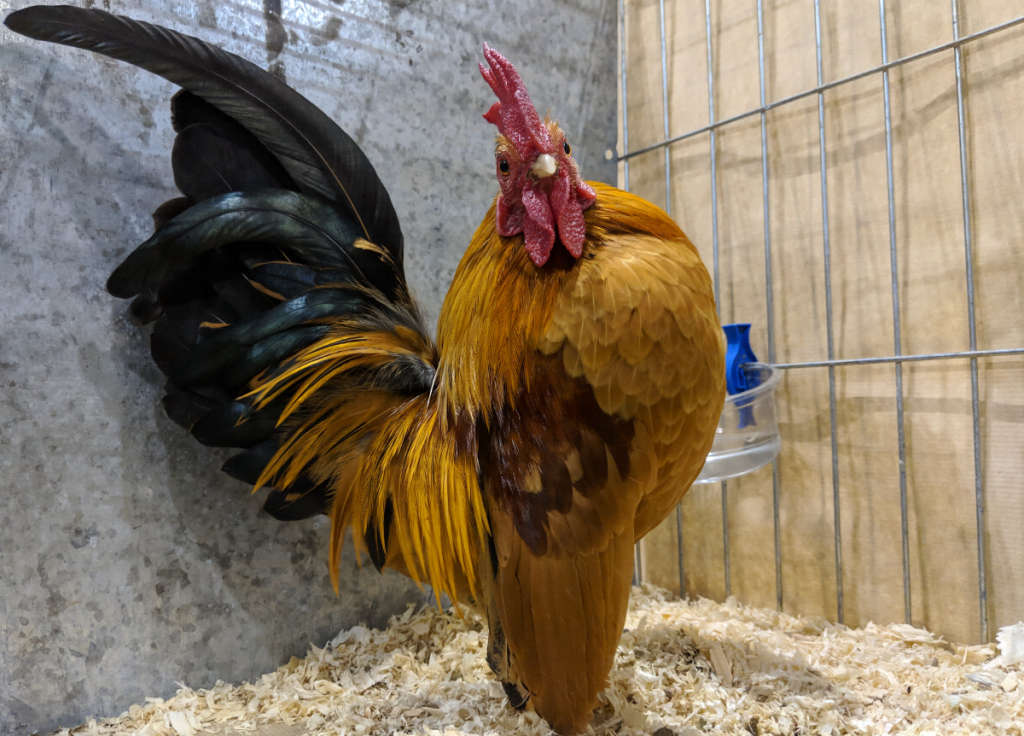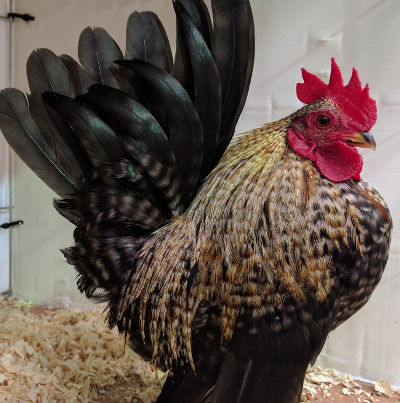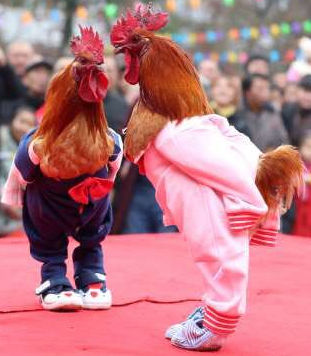Showing Serama bantams.

Showing chickens can be a rewarding pastime, although it does have its pressures and problems. Before showing you should read carefully the breed standard in depth first and make sure the bird you are entering into the show meets as many aspects of the desired standard as closely as possible.

A great deal rides on the interpretation both you and the judges put on the standards and there is always a little variability. The Serama is shown differently in some countries. In the UK and the US birds are show against a standard whereas in Malaysia they are required to perform.
Malaysian Serama beauty contests:
In Malaysia and Indonesia Serama are not exhibited in the same way as we do here in the UK. Serama are not exhibited alongside other varieties of poultry, nor are they exhibited in small cages. They are required to perform on a table in front of many people.
The chicken beauty pageant is a lucrative and brutal business in which the owners can make and lose small fortunes.
Below: Malaysian beauty pageants have many entrants.

At these pageants poultry are judged based on their wings, feathers, tail, colour and comb. Besides its looks, the chicken’s style and confidence also pose as a contributing factor to winning the title.
So how do you even determine a chicken’s confidence? By paying attention to the way it walks, struts and puffs out its chest. The special thing about Serama chickens is that they naturally stand with their heads lifted toward the sky and their wings downward. Some would say that they look like warriors ready for battle.
Chickens with higher chances of winning the title can fetch up to USD10,000 and the eggs are worth a fortune as well, no wonder there is so much competition.
Standard Malaysian beauty contest scoring and categories.
Scoring table at the very bottom of the page.
There are several categories in which Serama can be entered:
- Anak meaning a chick between 1 and 3 months of age (these birds must be very small, but you must be able to tell the sex of the bird clearly by comb, the weight limit for this category is 150g)
- Remaja meaning adolescent between 3 and 6 months of age (birds must be young and have not yet developed more than 5 feathers to each side of the tail)
- Muda meaning between 5/6-8/9 months depending on how mature the line is with regards to feather development (must have 6 feathers developed to each side of the tail)
- Alam Belum Siap meaning a bird which is incompletely developed with regards to feathering, eg has not fulfilled a full moult and retains "Muda" or "Remaja" age feathering but is over 7 months of age. It is possible for adult specimens up to 2 years of ago to compete in these classes provided they are of exceptional shape and temperament and do not posses full adult plumage.
- A class meaning very small birds weighing no more than 351g and aged over 10 months.
- B class meaning larger ll birds weighing more than 351g and over aged 10 months.
While there are six regular classes for males there is only one female class in which females above 5 months may be entered, this is called Induk. Size in this class is not relevant as all emphasis is placed on beauty and maturity.
Birds destined to be shown need to be kept in clean conditions to maintain optimum condition in order to do well at a show. It is also best to house show-birds individually during the showing season to prevent other birds from damaging their plumage.
Birds must be properly cleaned. The best way to do this is to bath your chickens in a gentle pet or baby shampoo with warm water about 35C. Do not cut, trim, dye or colour feathers or use chemicals, gel or hairspray.
Ensure your chickens plumage is clean with no dirty marks or staining around the vent.
Wash your bird's face & comb gently with a warm damp cloth taking great care around the eyes
Wash your birds legs and clean the scales to remove trapped dirt. An old toothbrush comes in handy for this job, though remember not to use it for yourself afterwards.
You may allow your bird to dry naturally provided it is kept in a warm environment where there are no draught to chill it. A hairdryer on low heat works quite well and speeds up the drying process. Not all chickens take to a dryer at the first attempt and it may take some time to get them used to it.
Ensure all nails are trimmed and shaped and the beak is also trimmed and in good shape
A small amount of Vaseline or baby oil on legs, comb and wattles greatly enhances the appearance of the show-bird. Be careful not to get any on the feathers as this gives a horrible greasy appearance.
If you remember the three T's of Serama showing, Type, Temperament and Tail I feel sure you will get success.
| Score | Anak | Remaja | Muda | Alam Belum Siap | A class | B class | Induk |
| Gaya (Style) | 15% | 20% | 25% | 25% | 25% | 25% | 25% |
| Tubuh (Body) | 10% | 10% | 15% | 15% | 15% | 15% | 15% |
| Ekor (Tail) | 10% | 12% | 13% | 15% | 15% | 15% | 15% |
| Kepala (Head, Beak & Comb) | 5% | 8% | 8% | 8% | 8% | 8% | 8% |
| Warna (Colour) | 5% | 10% | 10% | 10% | 10% | 10% | 10% |
| Hawa (Condition) | 4% | 4% | 5% | 5% | 5% | 5% | |
| Sayap (Wing) | 5% | 5% | 7% | 7% | 7% | 7% | 7% |
| Lawi (Sickle feathers) | 0% (as are not developed) | 0% (as are not developed) | 0% (as are not developed) | 0% (as are not developed) | 5% | 5% | 0% (females do not have sickle feathers) |
Kaki/Alas (Legs and feet) | 5% | 5% | 5% | 5% | 5% | 5% | 5% |
| Bulu (Feather) | 5% | 5% | 5% | 5% | 5% | 5% | 5% |
| Jumlah (total) | 64 | 75 | 92 | 95 | 100 | 100 | 95 |
What do they look for in Serama beauty contests?
Warna - This is the colour of the bird, in Malaysia colours do determine how well a bird does in shows. The highest score is 10% but this is rarely awarded, with a score of between 8 or 9 being usual.
The more beautiful the colour and the more shine on the feather the higher the points allocated. Colours which are given preference are reds, golden, lemon / yellow-buff, black-red and browns. Less popular are whites, dirty whites, mottled and greys. Beautiful vivid and bright coloured birds are far more likely to gain higher points at a beauty contest.
Lawi - This is the 2 ornamental sickle tail feathers which are pronounced in males and are situated right at the very front of the tail, closest to the neck. The sickle feathers must be equal in length and they must extend approximately one inch above the rest of the tail,and should be stiff and held straight in an upright position.
Soft flopping sickles are faulty and undesirable. Those which are too long and curl over are also undesirable.The full score for perfect sickles is 5%.
Ekor - This is the tail and how it is carried. The main tail feathers, the ones immediately after the sickles should overlap slightly and uniformly over one another. There should be 5 or more main tail feathers on each side of the tail and they should all be of complimenting lengths, meaning that they should taper in size neatly.
For example short feathers in between correct length feathers are not attractive. The side hangers, which are the soft glossy crescent shaped feathers which hand over both sides of the tail should be, well curved, be glossy with lustrous shine and there should be 5 or 6 of these each side of the tail. Both sides of the tail must complement each other and be equal in quantity. The tail should be of medium fullness, and not overly fanned or overly tight. The highest score for a perfect tail is 15%.
Sayap - This means wing carriage. The wings on a Serama are very important to the entire stance of the bird, and must be held in vertical position when the bird is relaxed. An excited bird must not pull the wings backwards and up, this is poor form and such birds are disqualified.
When excited or in beauty contests the Serama should lift it's wings forward in front of the legs as though a puppet lifting it's arms as was described by the breed's creator Wee Yean Een, after a character "Sri-Rama" from these plays the Serama took it's name.
The wings should not be too long so as to prevent upright chest carriage or so as to cause a bird to lean forward to accommodate its wings. The perfect length of the wing is to the level of the foot and not dragging the floor. The maximum points score for perfect wings is 7%.
Kaki /Alas - This means the feet (kaki) and legs (Alas). The Serama's legs must be fairly long, though not overly long so as to make the bird appear overly tall. Serama must never have short stumpy legs like the Japanese bantam, this is severely discouraged.
A very bad trait. In Malaysia the Serama has strong straight legs which should stride confidently without the appearance of squatting or bending the knees excessively. Points are deducted for birds which squat during a beauty contest. The highest points score for perfect legs is 5%.
Tubuh - This means the body. In Serama the body must be held upright, with a full breast and short back so as the neck touches the tail without leaving a gap. A well developed and muscular body is highly desirable, with a double breast seeming to be very popular at competition. The highest score for a perfect body is 15%.
Bulu - This means the feather condition. Serama must be beautiful, and so the condition of the feathers plays a big role in it's appearance of divine beauty. All feathers should be intact and in good condition with no signs of damage, fading, or scrubbing.
In Malaysia birds are dipped in water daily to prevent the feathers from becoming dry and brittle, thus maintaining a beautiful lustre and sheen to the feathers and preventing splitting and curling. A smooth, tidy and unruffled look is desired at a beauty contest. The maximum points score for perfect feathers is 5%.
Kepala - This means the head and it's attributes including comb, wattles and beak. The head of the Serama must be held at over 90 degrees, right back as far as possible with some birds head position being lower than the top of the breast. Such birds attain Champion placings and are sold for very high prices, with some birds achieving what some people earn in 2 years!
The head of the Serama is small, broad with a strong curved beak which should be yellow. The earlobes should be only red.The comb should be relatively small and smooth with 4-6 serrations which should be neat and fine. The maximum points score for a perfect head is 8%.
Gaya - This means overall style or type of the bird and makes up a quarter (25%) of the points available in the show. The Serama is defined by it's Gaya. It is proud, confident and striding in motion. A Serama in a beauty contest must flap its wings, lift it's legs high like a soldier on parade, and have what is known as a tremulous neck where the neck shivers when the bird becomes excited.
An overall exaggerated and flamboyant display of motion. The Serama should appear fearless and dominate the table with it's posturing, flapping and circling motions. A bird which lacks confidence, style, presence or remains still for too long is penalised and awarded a low score.
